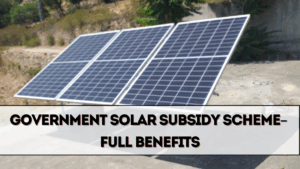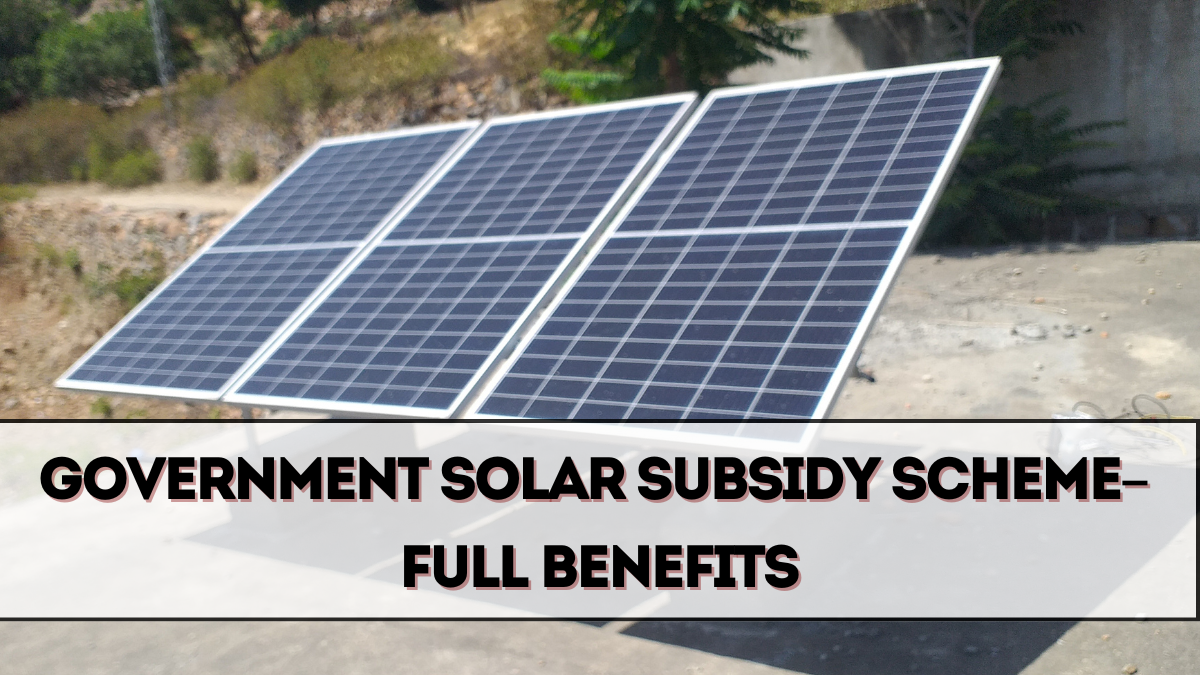India is rapidly transitioning toward renewable energy, with solar power taking center stage in this green revolution. To encourage widespread adoption, the government has rolled out the Govt Solar Subsidy India 2025 program, designed to make solar panels and power backup solutions more affordable for households, businesses, and industries. This scheme plays a crucial role in achieving India’s renewable energy targets while reducing dependence on fossil fuels.

Why Solar Subsidies Are Important
Solar installations often involve high upfront costs, which discourage households and small businesses from adopting them. Subsidies bridge this gap by:
-
Reducing Initial Investment: Lowering the financial burden of purchasing and installing panels.
-
Encouraging Power Independence: Allowing households to generate their own electricity.
-
Supporting Green Goals: Reducing carbon emissions and promoting eco-friendly practices.
-
Boosting Rural Development: Providing sustainable energy access in off-grid areas.
-
Promoting Employment: Creating jobs in manufacturing, installation, and maintenance sectors.
By making solar power affordable, the government ensures greater participation across all sections of society.
Key Features of the Solar Subsidy Scheme 2025
The Government Solar Subsidy Scheme 2025 includes several attractive features for different categories of users:
-
Residential Homes: Subsidies up to 40% for rooftop solar systems up to 3kW capacity.
-
Housing Societies: Special incentives for community solar projects.
-
Industrial Units: Tax benefits and subsidies for adopting large-scale solar power backup.
-
Agriculture Sector: Financial aid for farmers to install solar pumps and reduce irrigation costs.
-
Hybrid Systems: Support for solar plus battery backup installations.
These features make solar power more accessible to both urban and rural communities.
Eligibility Criteria for Subsidy
To avail the benefits of Govt Solar Subsidy India 2025, applicants must meet certain conditions:
-
The solar system must be installed by government-approved vendors.
-
The applicant must own the building or land where the system is installed.
-
Grid connectivity compliance is mandatory.
-
Proper maintenance and performance reports need to be submitted.
-
In the case of industries, the unit must be registered and adhere to energy efficiency norms.
This ensures transparency and accountability in subsidy distribution.
Benefits for Households and Industries
The scheme benefits both residential and industrial users in different ways:
-
For Households: Reduced electricity bills, backup during power cuts, and long-term savings.
-
For Industries: Lower operating costs, improved sustainability image, and compliance with green mandates.
-
For Farmers: Affordable irrigation with solar pumps, reducing dependency on diesel.
-
For Communities: Better access to reliable power in rural areas through shared systems.
Thus, the subsidy impacts individuals, communities, and businesses alike.
Application Process for Subsidy
The government has simplified the process to encourage maximum participation:
-
Visit the National Portal for Rooftop Solar or respective state energy department portals.
-
Register with property and identity details.
-
Select a government-approved vendor and system type.
-
Upload necessary documents including electricity bills and property proof.
-
After verification, installation is approved, and the subsidy amount is credited directly to the applicant’s bank account.
This transparent process reduces delays and eliminates middlemen.
Impact on Renewable Energy Goals
India has set ambitious targets of achieving 500 GW of renewable energy capacity by 2030, with solar contributing a major share. The Govt Solar Subsidy India 2025 scheme contributes by:
-
Encouraging mass adoption of rooftop solar systems.
-
Expanding solar penetration in rural areas.
-
Promoting solar-based power backup solutions for small industries.
-
Driving innovation in solar manufacturing within India.
This makes solar not just an energy alternative but a national mission.
Challenges in Implementation
Despite its promise, the subsidy scheme faces certain hurdles:
-
Awareness Gaps: Many citizens are still unaware of the scheme’s benefits.
-
High Upfront Costs: Even after subsidies, installation costs may remain a barrier for low-income households.
-
Grid Integration Issues: Rural areas face technical challenges in integrating solar systems.
-
Maintenance Costs: Long-term upkeep requires trained professionals and added expenses.
The government is addressing these issues through awareness drives, simplified loans, and partnerships with private players.
Future of Solar Power in India
The Govt Solar Subsidy India 2025 scheme marks only the beginning. The future is expected to bring:
-
Smart Solar Systems: AI-based monitoring for better efficiency.
-
Cheaper Solar Panels: With rising domestic manufacturing under Make in India.
-
Energy Storage Growth: Wider use of lithium-ion batteries for power backup.
-
Community Solar Parks: Shared solar hubs for rural villages.
-
International Partnerships: Collaborations under the International Solar Alliance (ISA).
These developments will ensure India remains a global leader in renewable energy.
FAQs
What is the Govt Solar Subsidy India 2025 scheme?
It is a government initiative offering financial assistance to households, industries, and farmers to adopt solar power.
How much subsidy is available for households?
Up to 40% subsidy is available for rooftop solar systems of up to 3kW capacity.
Who is eligible for the subsidy?
Homeowners, industries, and farmers using approved vendors and grid-compliant systems are eligible.
How can I apply for the subsidy?
Applications can be made online through the National Portal for Rooftop Solar or state energy department websites.
Click here to know more.
